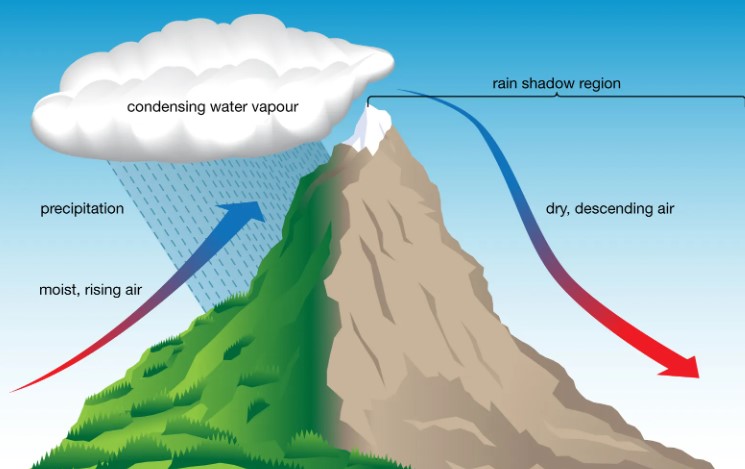The orographic effect, also known as the rain shadow effect, is a meteorological phenomenon that occurs when moist air is forced to rise over a topographic barrier, such as a mountain range, causing the air to cool and condense, resulting in precipitation on the windward side of the mountain. However, as the air descends on the leeward side of the mountain, it becomes warmer and drier, leading to reduced precipitation and the formation of a rain shadow.
The process of the orographic effect begins with moist air being carried by prevailing winds toward a mountain range. As the air approaches the mountain, it is forced to rise due to the barrier. This rising air cools as it gains altitude, leading to condensation and the formation of clouds. As the air continues to rise, the water droplets in the clouds grow larger, eventually falling as precipitation.
The side of the mountain where the air rises and precipitation occurs is known as the windward side. This side of the mountain tends to be more lush and green, with higher precipitation and cooler temperatures. In contrast, the opposite side of the mountain where the air descends is called the leeward side or rain shadow side. On this side of the mountain, the air descends and becomes warmer and drier, causing precipitation to be reduced and the region to be arid.
The size and shape of the mountain range can affect the amount of precipitation that falls on the windward side and the intensity of the rain shadow effect on the leeward side. Higher mountains tend to produce more precipitation on the windward side and create more pronounced rain shadows on the leeward side. Additionally, the direction of prevailing winds can also influence the location and intensity of the rain shadow effect.
The orographic effect can have significant impacts on ecosystems and human communities. On the windward side of a mountain range, the increased precipitation can support lush forests and diverse ecosystems. In contrast, the arid conditions on the leeward side can make it difficult for plants and animals to survive, leading to barren landscapes and deserts.
Human communities can also be affected by the orographic effect. In some cases, the rain shadow effect can make it difficult to sustain agriculture and access fresh water. However, the availability of water resources on the windward side of a mountain range can also create opportunities for human settlement and economic development.
The orographic effect, or rain shadow effect, is a meteorological phenomenon that occurs when moist air is forced to rise over a topographic barrier, causing precipitation on the windward side and creating an arid rain shadow on the leeward side. The size and shape of the mountain range, as well as prevailing winds, can affect the intensity of the orographic effect and its impact on ecosystems and human communities.

Characteristics of orographic rainfall
Orographic rainfall, also known as relief rainfall or topographic rainfall, is a type of precipitation that occurs when moist air is lifted up and over a mountain range, leading to cooling and condensation of water vapor, followed by the formation of rain or snow. The following are the characteristics of orographic rainfall:
-
Occurs on the windward side of the mountain: Orographic rainfall occurs on the windward side of the mountain range, where moist air is forced to rise up and over the mountain, leading to the formation of clouds and precipitation.
-
Creates a rain shadow on the leeward side: The leeward side of the mountain range, also known as the rain shadow, receives little or no precipitation due to the descending dry air.
-
Increases with altitude: Orographic rainfall increases with altitude because the air cools as it rises, leading to higher levels of condensation and precipitation.
-
Creates distinct climatic zones: The orographic effect can create distinct climatic zones on either side of the mountain range. For example, the windward side of the mountain can have a temperate or wet climate, while the leeward side can be dry or arid.
-
Influenced by the shape of the mountain range: The shape and orientation of the mountain range can influence the amount and distribution of orographic rainfall. Mountains with a steep windward slope and a gentle leeward slope tend to produce more orographic rainfall, while those with gentle slopes on both sides produce less rainfall.
-
Creates lush vegetation: The windward side of the mountain range that receives orographic rainfall can create lush vegetation, including forests and grasslands, due to the high moisture levels.
-
Can cause flash floods: Orographic rainfall can cause flash floods due to the rapid accumulation of water on the windward side of the mountain range.






